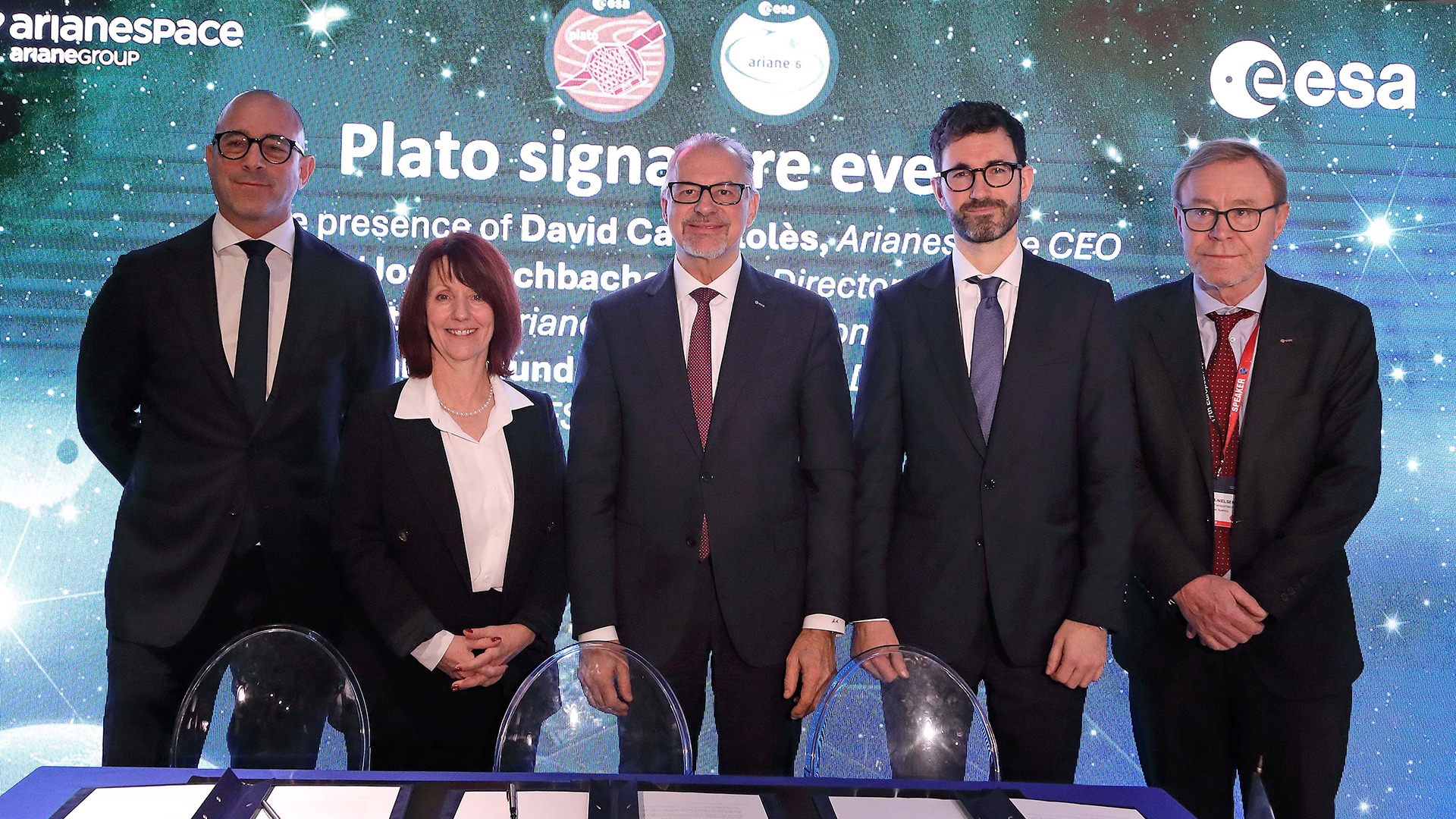Arianespace to launch ESA's space telescope PLATO with Ariane 6
29.01.2025

- Arianespace will launch ESA’s PLATO scientific spacecraft on board an Ariane 6, end of 2026.
- PLATO (PLAnetary Transits and Oscillations of stars) will study terrestrial planets in orbits up to the habitable zone of Sun-like stars, and characterise these stars.
- Arianespace continues to support European scientific missions, advancing space exploration and the better understanding of the Universe.
At the 17th European Space Conference, Arianespace announces it has been awarded the contract to launch the European Space Agency’s (ESA) terrestrial planet hunter PLATO (PLAnetary Transits and Oscillations of stars) satellite. PLATO will board the heavy-lift Ariane 62, for a launch from Europe’s Spaceport, in French Guiana, end of 2026, and will be placed into orbit around the Sun-Earth Lagrange point L2. By orbiting PLATO, the Ariane 6 will demonstrate its capability to ensure precise orbital insertion for complex exploration missions.
David Cavaillolès, CEO of Arianespace, commented: “After major scientific missions like JUICE, BepiColombo, and of course the James Webb telescope, PLATO’s launch with Ariane 6 continues Ariane’s key role in the quest to discover other worlds and the exploration of the universe. We express our pride and gratitude towards our historic partner the European Space Agency for their trust. Our teams are most enthusiast to closely working together to bring this extraordinary European exploration spacecraft to orbit with Ariane 6. This new contract takes Arianespace’s backlog to 32 Ariane 6 booked, demonstrating once again that Ariane 6 is perfectly suited to European and international needs, including the most complex ones.”
Ariane 6 is designed to launch a variety of customer mission profiles, including LEO constellations, GEO telecom and broadcast satellites, MEO Galileo navigation payloads, and other European institutional secure communication, science and exploration missions. Perfectly adapted to the market, Europe’s new heavy-lift rocket allows Arianespace to best tailor to the ambitions of our institutional and commercial customers.
Toni Tolker-Nielsen, ESA Director of Space Transportation, commented: “This is the first science mission that our new rocket Ariane 6 will launch, and the first mission that the versatile launcher will send to the Lagrange 2, 1.5 million kilometers from the launch pad, a new destination for our heavy-lift rocket to show its prowess.”
Carole Mundell, ESA Director of Science, said: “Most of ESA’s Science flagship missions have been launched on Ariane rockets. From Rosetta to Webb and Juice, Arianespace has ensured exquisitely accurate delivery of our precious technologies into deep space, increasing mission lifetimes and scientific performance. So it comes naturally to launch Plato on Europe’s newest rocket, confident that it will take our spacecraft exactly where it must be.”
Designed to detect and characterize Earth-like exoplanets, PLATO will utilize a unique array of 26 cameras to observe hundreds of thousands of stars with unprecedented precision. Using such a large number of cameras will enable a combined higher ‘signal-to-noise’ ratio and larger field of view than has been possible with previous missions. Through the observations of bright stars, PLATO will assemble the first catalogue of confirmed and characterised planets with known densities, compositions, and ages, which will include planets in the habitable zone of Sun-like stars. PLATO’s will revolutionise our understanding of planet formation and the evolution of planetary systems, as well as the potential habitability.
PLATO is an ESA-led mission, with Germany’s OHB System AG nominated as prime contractor. The spacecraft will be built and assembled by OHB together with Thales Alenia Space in France and the UK and Beyond Gravity in Switzerland. The scientific payload, consisting of the cameras and electronic units, is provided through a collaboration between ESA and the PLATO Mission Consortium. This Consortium is composed of various European research centres, institutes and industries.